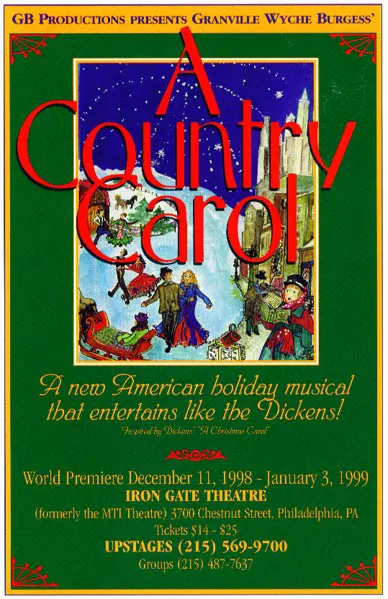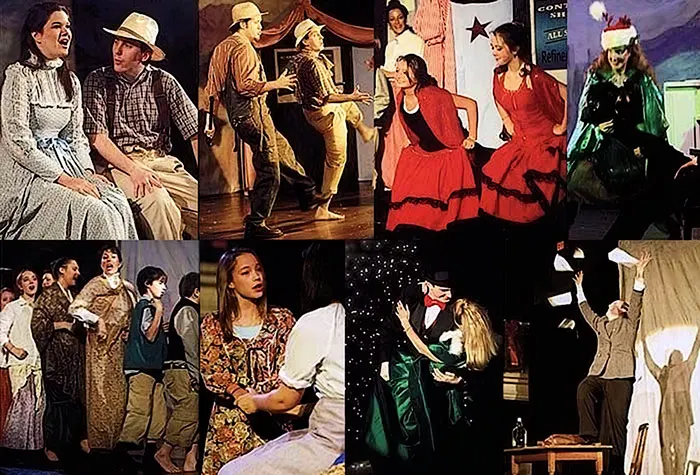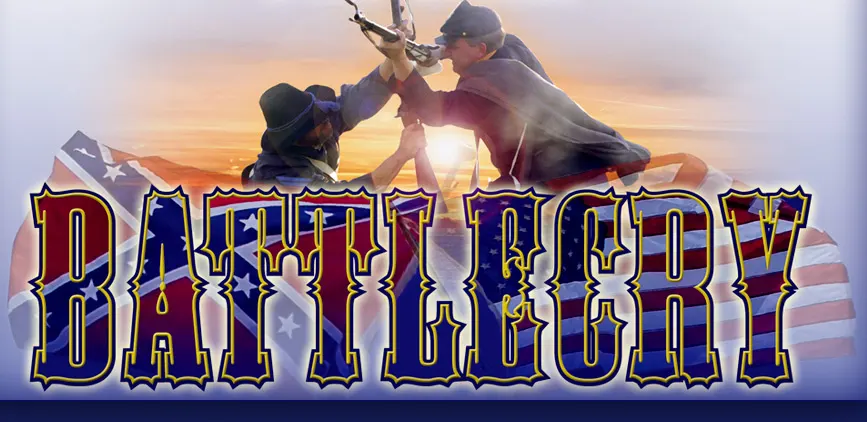Musicals
Musicals
Common Ground – visit website →
Conrack the Musical – visit website →
A Country Carol
 Doubling allows for 6 principals and 5 chorus, with additional chorus where desired.
Doubling allows for 6 principals and 5 chorus, with additional chorus where desired.
“A Country Carol” changes some of the specifics of Dickens’ classic tale while retaining its essential structure and message. It is the story of a soul seduced by show business, lost in the pursuit of money and fame. Unlike Dickens, it is chiefly a love story, and the family that finds itself together at last on Christmas Day is Ebben’s own.
Major changes from original:
- Ebbeneezer is as rich and cold-hearted as ever, but now he’s a Broadway producer at the turn of the last century who has sold his soul for fortune and fame.
- Young Ebben is a “hick from the holla” whose boundless ambition drives him to New York, away from his wife Belle, and into the arms of an older actress.
- Cratchit is torn between his love for Belle and his loyalty to his best friend.
- Tiny Tim is now Tina, a little girl crippled by the loss of a father she never knew.
— And who has set all this in motion? The Big Guy, who is re-writing Dickens to emphasize the love story, add humor to the ghosts, and infuse the whole with trademark American buoyancy and hope.
* * *
Our story begins with an embittered Ebben, a successful actor/writer/producer in New York City in 1909, delighting, in “Christmas Is,” that the Christmas spirit is spelled “b-u-y!” Working for him is Gloria, an aspiring actress, who, joined by the rest of the company, counters with the joyous “It’s Christmas Everywhere!” Returning home, Ebben is frightened by the ghost of Jake, his partner-producer during his climb to the top of the New York theatre world. Jake’s Ghost warns Ebben to reform his ways and, together, they spin back through time to re-visit Ebben’s past in Butterfly Holla, West Virginia, 1898.
The Holla Folk are celebrating the annual pig roasting in the rousing “Hog Heav’n,” led by their preacher-man, Cratch. Young Ebben doesn’t participate. He is up on Bald Rock composing a new song. When his wife, Belle, finds him there, he sings that he wants to leave the holla and live a full life, to play every note in a “Song Called Me.” He gets his wish when a traveling carnival man, Jake, hears him singing and signs him to a vaudeville contract, prompting Young Ebben to joyously sing “Gettin’ the Hell Outta the Holla.” Young Ebben’s German immigrant act is not popular with the audience, but his attractive, sexy acting partner, Lydia, persuades Jake to let Young Ebben write his own material, a comedy number called “Po White Trash.” When a New York producer wants to star Young Ebben and Lydia in his latest musical, he finally gets to realize his dream of leaving the holla. Belle lets him go, but not before telling him he must carry all the sounds and feelings of the holla with him—he must “Listen to the Land.” What she doesn’t tell him is that she is pregnant, because she doesn’t want to stand in the way of his dream. Young Ebben promises that he will always remember where his true home is. Belle convinces him to take Cratch with him—she knows Young Ebben will probably need some looking-after. Cratch can’t prevent Young Ebben’s seduction by fame and fortune, however, and at the opening night performance, Belle catches Young Ebben in a passionate embrace with Lydia. Declaring herself “An Ol’ Mountain Woman,” she returns to the holla with Cratch, where, unbeknownst to Young Ebben, she will give birth to their daughter, Tina(Tiny Tim). Young Ebben swears that he’ll make it big and get rich and “Never Go Back to the Holla,” as Jake’s Ghost gestures to bring an end to Ebben’s journey to his past, and to Act One.
In Act II, ten years have passed as the Ghost of Christmas Present, who is Ebben’s mother, takes Ebben back to Butterfly Holla, where Cratch has managed to build a church and the Holla folk celebrate with the gospel song “Let It Rise!” When Cratch finally finds the courage to ask Belle to marry him, she works through her feelings in “Belle’s Dilemma:” she still loves Ebben but knows Tina needs a father. Tina, however, wants her real father, and, missing him, plaintively asks “Do I Believe in Santa Claus?” When her answer is “no,” Belle decides to tell her that her father is not dead, as she had previously told her, but alive and probably living in New York. Terribly hurt by this lie, Tina angrily runs off. Ebben, of course, has witnessed this scene between the woman he still loves and the daughter he didn’t know he had, but he is unable to speak to them or make them see him, causing him tremendous anguish. Alone, Belle sings the beautiful waltz, “Second Chances,” pining for a second chance with Ebben, and he, still unseen, joins her in loving harmony, pining for the same thing.
The Ghost of Christmas Future appears and takes Ebben to his New York penthouse ten years in the future, 1919, where Older Ebben sings of the joys of money in “You Can Count On It,” and unfeelingly refuses to grant the washed-up Lydia even a part in the chorus in his latest musical hit. When the ghost takes Older Ebben back to the holla, in a twist on Dickens, he learns that it is not Tina who has died, but Belle. The Holla Folk lay her to rest in the “Singin’ of a Spirit.” Older Ebben has lost his beloved and the daughter he never knew he had. He also has learned that, with Death, comes the loss of feeling, and he can never feel again. Devastated, he sings the haunting “When The Music Stops,” asking how he can possibly go on living. The answer comes when he begs forgiveness, promises to honor Christmas in his heart, and pleads to be allowed to feel again. Redeemed, the ghost whisks him back to New York City, where he discovers it has all been a nightmare of a dream. He joyously sings “Gettin’ Back to the Holla,” and hurries there to find Belle and Tina, where they reprise “Listen to the Land.” The whole company then ends the show singing Ebben’s newest song, one he will be content to stay in the holla and sing for the rest of his days: “A Country Carol.”

Notes on Production
The stage should feel like a magical place, but not “cartoony.” Great fun should be had with the appearances of the ghosts, and any opportunity for fun should be seized if it fits the mood of the scene. Similarly, when Ebben and the Ghosts “time travel,” music, lights, and “body movement” should be employed to great effect.
The scenes should flow from place to place without much, if any, time spent changing scenery.
SETTINGS:
Since there are numerous settings, a unit set with suggestions of changes in place might be best. Butterfly Holla should feel open and free, with a sense of the altitude of high mountains. New York scenes should feel cramped and stifling. Stage scenes can be indicated by merely changing the Announcement Placard on the side of the stage.
A set with simple furnishings, with perhaps a street lamp to indicate city exteriors, will best serve the film-like seamlessness of scene-flow.
COSTUMES:
The ghosts should resemble a parody of the Dickens’ ghosts, as indicated. All other costumes are realistic.
LIGHTING:
Inspired lighting can greatly enhance the production, especially in achieving magical effects.
SOUND:
There are several sound cues which are integral to the plot.
On To Oklahoma
ACT ONE:
Grampa is telling George and Alice, his grandchildren, a “windy” about the booming of the Oklahoma territory in the 1880’s. They don’t want to listen, but agree to when Grampa tells them they can be in the story. It is the aniversary of the great Run to the Promised Land in 1889.
Dave Payne is gathering folks to cross the border illegally into Oklahoma to boom the land by forcing the government to open it for settlement. He, his comon-law wife, Anna, their son George, and Bill Couch sign up Frank McPherson and his children, Sarah and Alice. Marsh Murdoch scoffs at the notion, but Payne thinks he has the man who will make thousands follow him: Pawnee Bill. At the last moment, Pawnee joins Buffalo bill’s Wild West show instead, but Frank knows the way and the expedition is on.
Meanwhile, two cowboys, Jim and Dusty Dan, come in from the range. Jim meets Sarah, they get off on the wrong foot, but Sarah is eventually won over enough to share her dream with Him: planting an acorn on her own special spot in Oklahoma. Jim is torn between his growing love for Sarah and his knowledge that nesters like her will destroy his way of life forever.
In a saloon brawl, Jim saves the life of an Indian, Lone Wolf, when Jake Adams, Jim’s rival for trail boss, tries to stab him. Lone Wolf promises to repay the debt someday.
Out on the prairie, Jim, Dusty, and Jake show the cavalry where the boomers are camped. Jim is forced to identify Payne, thus sending him to prison and driving a wedge between him and Sarah which Charlie Wickmiller, a photographer from Back East, is happy to fill.
Charlie’s pictures make Payne’s movement to settle the Oklahoma territory nationally known. The President and congress are forced to deal with Payne’s demands. They do so in typical Washington fashion: passing the buck. Payne, disgusted, returns to Wichita to organize another expedition and learns that his fight in the courts has paid off: a judge has declared that settling Oklahoma is no longer illegal!
At this point, Ben Miller, the cattle baron, takes matters into his own hands and has Jake Adams deliver Payne a bottle of poisoned whiskey. Tragically, Payne dies-on the verge of realizing his dream.
At the funeral, Jim tries to explain his behavior to Sarah, but she won’t listen, so he decides to join Pawnee Bill’s Wild West Show and get as far away from Sarah as possible. Now who will lead the settlers into the Oklahoma Territory? As Payne’s coffin is lowered into the grave, Bill Couch steps forward and promises to lead the Boomers to the Promised Land.
ACT TWO:
Lone Wolf, who has followed Jim into the Wild West Show, convinces Jim to return to the Oklahoma Territory and leave this mockery of things they both hold dear. Once there, Jim spends time with Lone Wolf and his father, Eagle Chief, gaining a new appreciation for the land as something more permanent than a place to drive cattle over.
Jim tracks down Sarah, only to learn she is married to Charlie and they are making the Run. Jim decides to claim a special spot only he knows about and give the land to Sarah.
In a musicalized ballet, the Boomers reenact the Run of ’89. Jake kills Charlie in a land dispute, and Jim seeks frontier justice with his gun. Jake has Jim in his sights and is about to pull the trigger, when Jake suddenly falls dead. Lone Wolf steps out of the shadows: his debt is repaid.
Jim finally gets up his courage and asks Sarah to marry him. She accepts, and Grampa – who is Jim gown old-finishes his “windy” by dividing his claim in two and giving half to each of his grandchildren, passing the sacred land on to the next generation.
Battlecry - The Musical

In the early morning dawn of November 19, 1863, six figures appear at the site of the national cemetery in Gettysburg, Pennsylvania for the day’s dedication ceremony. Only two were soldiers in the monumental fighting that took place there four months earlier, but all bear the scars of battle.
Amelia Christianson, young, pretty, and affianced to Frank Smoker, a Union soldier. Frank is marching to Gettysburg. Quentin Johnson, a rebel, tells his friend Joe that he hopes to get some new boots for his bare feet. And while these characters are heading for town, two freed blacks, Isaac Hampton, and his wife, Sarah, are fleeing Gettysburg. Four soldiers and four citizens whose lives will intersect at the crossroads of the little town that saw the biggest battle of the Civil War.
Lee, Longstreet, Meade, Chamberlain, the iconic leaders, struggle with each other over how best to win while the battle is brought thrillingly to life through the dramatized diaries of real soldiers and citizens.
BATTLECRY is a heart-warming story of the real meaning of Lincoln’s “last full measure of devotion.” The songs will cheer you and move you, reminding us that even in the midst of terrible agony, there can be joy, love and healing.
Musicals for Children
Whalesong
WILLIE, a humpback whale from the “country,” is anxious to depart the waters of the Caribbean for the coast of New Jersey to meet again his truelove, WANDA, a female humpback from the “north.” He’s been practicing a song he wrote just for Wanda, but it’s “different” and maybe Wanda won’t like different. His buddy Dolph, a dolphin(surprise!) tells him that different is good, and, together with their turtle friend SAMANTHA, they swim north to the strains of “MOVIN’ ON UP THE LINE.”
When Willie finally sees Wanda, he is star-struck-her flippers, her tail, her fluke, the way she breaches leave him practically swooning. Her bluesy rendition of FLUKE SALUTE only adds to her appeal, but finally Willie gets up the courage to ask her to the fishfry and she says yes.
At the ‘fry, Dolph mocks the way humans always put spices on seafood and sings a “spicy” tango to the joys of eating the natural way: EAT IT PLAIN. Then the feasting begins. But Willie accidentally swallows a balloon dropped from a tourist boat. Wanda takes care of him, and this presents Willie his chance-with much prodding from Dolph-to sing her his song, “YOU SHAKE ME TO MY BONES.” Wanda is duly impressed, but just as they are about to kiss, she hears the motor noise from another tourist boat and, unable to resist the chance to perform her famous fluke salute, dashes off towards the boat.
Willie chases her (through the audience, if possible), warning her about the danger of boats. He is distracted, however, by the sudden appearance of a FISHERMAN, who apparently has fallen overboard and become trapped in his own fishing net. Singing whale songs to calm him down, Willie manages to use the sharp barnacles on his back to saw the fisherman free. As the man swims to the surface, Willie hears a terrible scream from Wanda.
The next morning, Wanda “wanders” in, her fluke heavily bandaged from a run-in with a boat propeller. Now she’s the “ugly” one, not Willie. Now she’s the one who’s “different.” The star singer has been brought down a notch or two. But that’s just the way Willie wants it. He convinces Wanda that there’s nothing wrong with taking the time to appreciate the things around you-“Slow down and smell the seaweed.” And, together, the whole company reprises the FLUKE SALUTE with its timeless message, “Whoever you are, you’re a star!”
